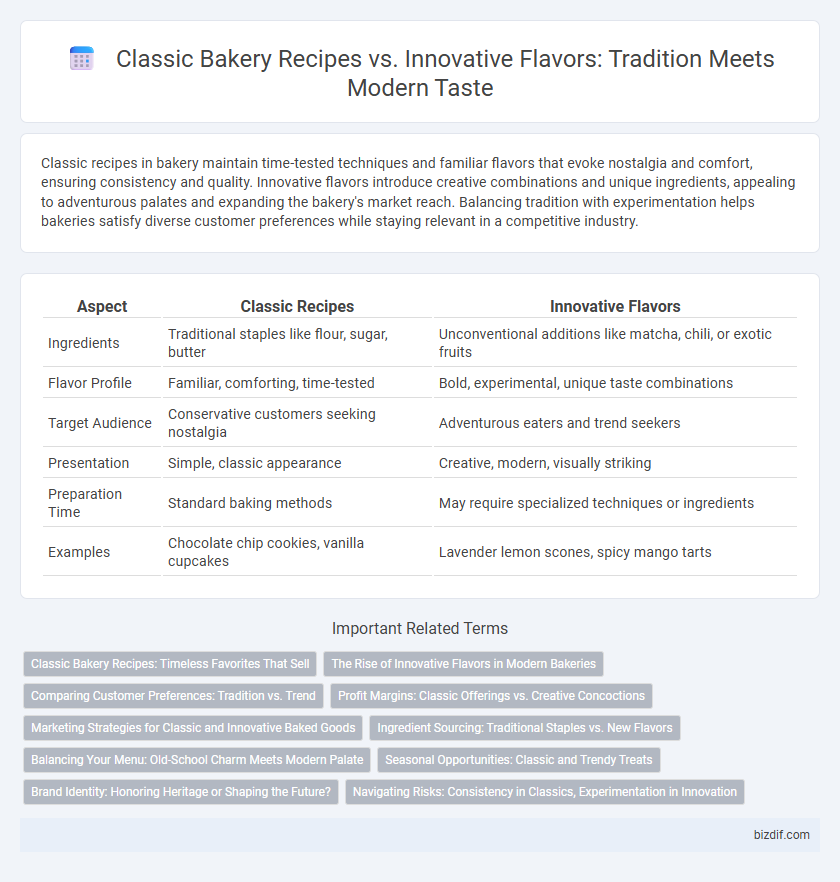Classic recipes in bakery maintain time-tested techniques and familiar flavors that evoke nostalgia and comfort, ensuring consistency and quality. Innovative flavors introduce creative combinations and unique ingredients, appealing to adventurous palates and expanding the bakery's market reach. Balancing tradition with experimentation helps bakeries satisfy diverse customer preferences while staying relevant in a competitive industry.
Table of Comparison
| Aspect | Classic Recipes | Innovative Flavors |
|---|---|---|
| Ingredients | Traditional staples like flour, sugar, butter | Unconventional additions like matcha, chili, or exotic fruits |
| Flavor Profile | Familiar, comforting, time-tested | Bold, experimental, unique taste combinations |
| Target Audience | Conservative customers seeking nostalgia | Adventurous eaters and trend seekers |
| Presentation | Simple, classic appearance | Creative, modern, visually striking |
| Preparation Time | Standard baking methods | May require specialized techniques or ingredients |
| Examples | Chocolate chip cookies, vanilla cupcakes | Lavender lemon scones, spicy mango tarts |
Classic Bakery Recipes: Timeless Favorites That Sell
Classic bakery recipes like sourdough bread, croissants, and chocolate chip cookies consistently attract customers due to their familiar tastes and comforting textures. These timeless favorites often drive steady sales by appealing to traditional preferences and evoking nostalgia. Mastering these recipes ensures a dependable menu foundation that builds customer loyalty and supports long-term business growth.
The Rise of Innovative Flavors in Modern Bakeries
Modern bakeries have witnessed a surge in innovative flavors, blending unconventional ingredients like matcha, lavender, and exotic fruits to attract adventurous consumers. This trend not only diversifies product offerings but also caters to evolving palates seeking unique taste experiences beyond traditional bakery staples. Embracing bold flavor combinations drives customer engagement and positions bakeries at the forefront of culinary creativity in the competitive food market.
Comparing Customer Preferences: Tradition vs. Trend
Customer preferences in bakery products often split between classic recipes and innovative flavors, with many favoring time-tested traditional items like sourdough bread and chocolate chip cookies for their nostalgic and comforting qualities. However, a growing segment seeks trendy flavors such as matcha, lavender, and turmeric-infused pastries, driven by curiosity and a desire for unique taste experiences. Sales data reveals that while classic offerings maintain steady demand, innovative flavors attract younger demographics and social media-driven markets, influencing bakery menu diversification strategies.
Profit Margins: Classic Offerings vs. Creative Concoctions
Classic bakery recipes often yield higher profit margins due to consistent demand and lower ingredient costs, ensuring steady revenue streams. Innovative flavors, while potentially attracting new customers and allowing for premium pricing, involve higher experimentation expenses and variable sales performance. Balancing traditional bestsellers with creative concoctions can optimize overall profitability and market appeal.
Marketing Strategies for Classic and Innovative Baked Goods
Marketing strategies for classic baked goods emphasize nostalgia and tradition, leveraging established customer trust and familiar flavors to drive consistent sales through storytelling and seasonal promotions. Innovative flavors require targeted campaigns highlighting uniqueness and experimentation, often utilizing social media engagement, influencer partnerships, and limited-time offers to attract adventurous consumers. Both strategies benefit from clear branding, quality visuals, and customer reviews to enhance appeal and build loyalty in competitive bakery markets.
Ingredient Sourcing: Traditional Staples vs. New Flavors
Classic bakery recipes rely on traditional staples such as unbleached wheat flour, pure cane sugar, and farm-fresh eggs, sourced from trusted local suppliers to maintain authenticity and consistency. Innovative flavors incorporate exotic ingredients like matcha powder, activated charcoal, and alternative sweeteners, often sourced from specialty markets and international producers to create unique taste profiles. Ingredient sourcing in both approaches emphasizes quality and freshness but differs in origin and novelty, reflecting the baker's commitment to either preserving tradition or embracing culinary experimentation.
Balancing Your Menu: Old-School Charm Meets Modern Palate
Balancing your bakery menu involves integrating classic recipes that evoke nostalgia with innovative flavors that excite contemporary taste buds. Traditional baked goods like sourdough bread, buttery croissants, and rich chocolate cake offer timeless appeal, while inventive options such as matcha-infused pastries, lavender honey tarts, and spicy pumpkin bread cater to adventurous customers. This fusion attracts diverse clientele by preserving old-school charm alongside fresh, trend-forward tastes.
Seasonal Opportunities: Classic and Trendy Treats
Seasonal opportunities in bakery allow for a dynamic blend of classic recipes and innovative flavors, driving customer engagement year-round. Traditional treats like pumpkin spice muffins in autumn provide comforting familiarity, while trendy flavors such as matcha or salted caramel introduce exciting variety. Leveraging seasonal ingredients enhances freshness and aligns products with consumer preferences, boosting sales in both timeless and contemporary categories.
Brand Identity: Honoring Heritage or Shaping the Future?
Classic recipes in bakery preserve brand identity by honoring heritage through time-tested flavors that evoke tradition and consistency, reinforcing customer loyalty. Innovative flavors, however, shape the future of bakery brands by integrating unique ingredients and modern techniques that attract adventurous consumers and differentiate the brand in a competitive market. Balancing these approaches allows bakeries to maintain authenticity while evolving to meet contemporary taste preferences and industry trends.
Navigating Risks: Consistency in Classics, Experimentation in Innovation
Classic bakery recipes provide consistent quality and customer satisfaction, relying on time-tested methods that maintain brand trust and reliability. Innovative flavors introduce creative variations, attracting adventurous customers but requiring careful testing to avoid alienating core clientele. Balancing the stability of classics with the novelty of innovation helps bakeries manage financial risks while expanding market appeal.
Classic Recipes vs Innovative Flavors Infographic

 bizdif.com
bizdif.com